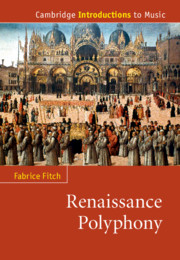Book contents
- Cambridge Introductions to Music
- Cambridge Introductions to Music Renaissance Polyphony
- Copyright page
- Dedication
- Contents
- Illustrations
- Figures
- Tables
- Music examples
- Acknowledgements
- Note on the music examples
- Note on the bibliography
- Abbreviations
- Chapter 1 Introducing Renaissance polyphony
- Chapter 2 Making polyphony: sources and practice
- Chapter 3 Makers of polyphony
- Chapter 4 Pitch: an overview
- Chapter 5 Voice-names, ranges, and functions
- Chapter 6 Mensural notation, duration, and metre
- Chapter 7 Genre, texts, forms
- Chapter 8 ‘Cantus magnus’: music for the Mass
- Chapter 9 ‘Cantus mediocris’: the motet
- Chapter 10 ‘Cantus parvus’: secular music
- Chapter 11 Scoring, texture, scale
- Chapter 12 Understanding musical borrowing
- Chapter 13 Canons, puzzles, games
- Chapter 14 Performance practice: a brief introduction
- Notes
- Glossary
- Bibliography
- Index of compositions
- General index
- Cambridge Introductions to Music
Chapter 4 - Pitch: an overview
Published online by Cambridge University Press: 13 August 2020
- Cambridge Introductions to Music
- Cambridge Introductions to Music Renaissance Polyphony
- Copyright page
- Dedication
- Contents
- Illustrations
- Figures
- Tables
- Music examples
- Acknowledgements
- Note on the music examples
- Note on the bibliography
- Abbreviations
- Chapter 1 Introducing Renaissance polyphony
- Chapter 2 Making polyphony: sources and practice
- Chapter 3 Makers of polyphony
- Chapter 4 Pitch: an overview
- Chapter 5 Voice-names, ranges, and functions
- Chapter 6 Mensural notation, duration, and metre
- Chapter 7 Genre, texts, forms
- Chapter 8 ‘Cantus magnus’: music for the Mass
- Chapter 9 ‘Cantus mediocris’: the motet
- Chapter 10 ‘Cantus parvus’: secular music
- Chapter 11 Scoring, texture, scale
- Chapter 12 Understanding musical borrowing
- Chapter 13 Canons, puzzles, games
- Chapter 14 Performance practice: a brief introduction
- Notes
- Glossary
- Bibliography
- Index of compositions
- General index
- Cambridge Introductions to Music
Summary
This chapter is the first of three that set out the basic building blocks of musical syntax in Renaissance music, beginning with those connected to pitch. The first section sets out the key concepts of music theory dating back to the time of Guido of Arezzo in the eleventh century, whose pertinence endures into the Renaissance (thus, the gamut, mode, the species of fourth and fifth, the so-called Guidonian Hand, and the hexachord). The next section lays out the complex (and at time fraught) relationship between these concepts and composed polyphony, laying bare in particular the tension between modes (which were initially adapted from Greek theory to classify plainchant) and polyphony. This is seen most obviously in the functioning of the most fundamental element of counterpoint, the cadence. The chapter concludes by considering other key elements of pitch-treatment, including musica ficta, dissonance treamtment, and enhanced or expanded chromatic practice.
- Type
- Chapter
- Information
- Renaissance Polyphony , pp. 46 - 65Publisher: Cambridge University PressPrint publication year: 2020

